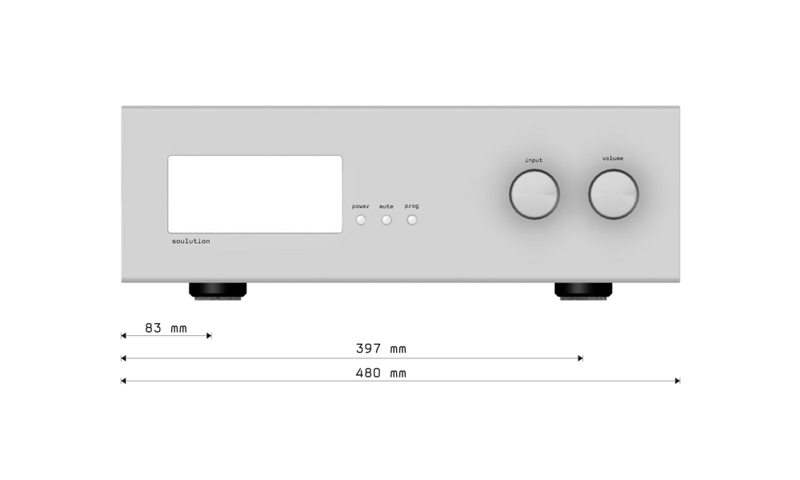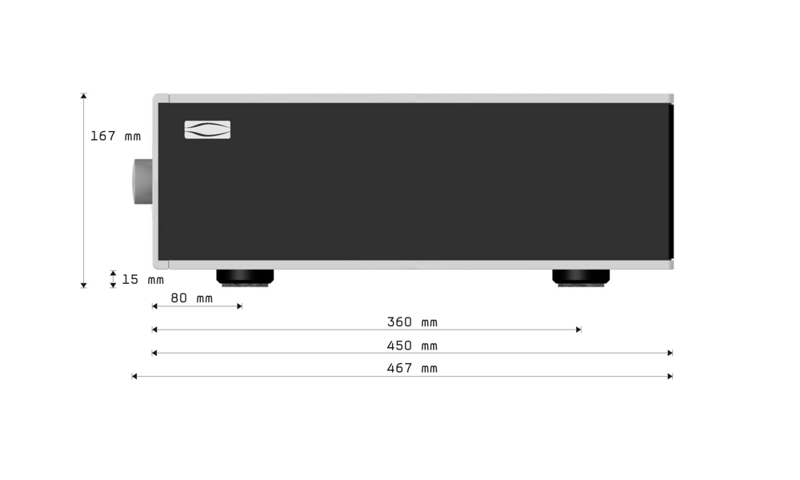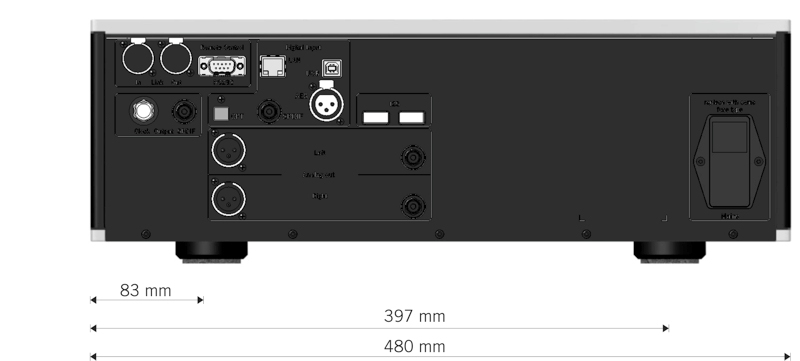







No deletions at the source are mandatory. This holds even more true for the playback of high resolution files as it did for CDs and SACDs anyhow. No amplifier or loudspeaker can ever make good for what has been lost at the source. The quality of the recording and the signal supplier are of fundamental importance in high fidelity.
The 760 D/A-Converter does excell at exactly this task. It captures all digital music data and transports it in the analog domain. No deletions, no additions!
Design
In many areas the 760 D/A-Converter is based on the same proven technical solutions used in the 745 SACD-Player. It also embodies the same principles in its design: top grade digital interfaces for optimal reception of the music data, a super-precise master clock generator to avoid jitter, intelligent digital signal processing with oversampling and Zero Phase technology, analogue output stages of top end preamplifier quality and a husky power supply.
The 760 D/A-Converter is packed with cutting-edge technology with one objective - the love of music. The parallels include a consistent dual mono design in the output stages and separate power supplies for digital electronics and the analogue stages. The 760 D/A-Converter adds a digital volume control that allows direct connection to a power amplifier.
Oversampling
A powerful SHARC DSP performs the 8x oversampling to 24bit/352.8 kHz or 24bit/384kHz, depending on the digital input signa,l with the utmost precision. We believe precision of interpolation is more important than high clock rates. Our players and D/A converters use an algorithm from the highly regarded Anagram Technologies followed by Burr Brown D/A converters in a digital symmetric configuration. As we consider the PCM conversion technology as superior, the DSD signals get converted before its final D/A conversion.
zero phase technology
The 760 D/A-Converter is equipped with soulution's innovative Zero-Phase-Technology. Smallest timing errors provoked by the analog low pass filter of the D/A converter get eliminated. Every D/A converter requires an analog low pass filter in its output in order to suppress high frequency noise and aliasing signals. The 760's 3rd order bessel filter, with a cut-off frequency of 120kHz, does show a phase shift of up to 15° in the audio band. Due to the Zero-Phase-Technology the phase error of the analog music signal remains below 1°, 20Hz - 100kHz! The Zero-Phase-Technology brings you even closer to the beauty of the source material! The music gets even more realistic and 3-dimensional with a lot of "air" around instruments and voices. As close to the source as possible! No detail gets lost.
Clock
Utmost precision of the clock signal is a must have for a top class D/A-Conversion. Lowest phase-noise behaviour is by far more important than long term frequency stability. Together with experts for highend oscillators we did develop a TCXO which is optimized for this application. It does not run on its first harmonic but on its 3rd overtone. The clock modules work at frequencies around 100MHz, this re-quires extremely fast amplifier stages within the oscillator loop but allows achieving best results regarding phase-noise. Even the best OCXOs or rubidium based oscillators are not able to outperform these specifications. The 760 DAC does have a spate oscillator module for signals based on 44.1kHz and signals based on 48kHz.
With the synchronisation to an external clock signal the performance of these oscillator modules would be deteriorated. Therefore the 760 does not provide a clock-input. However, external components can be synchronised to the 760 D/A-converters high quality clock signal through its clock-output.
D/A-conversion
Burr-Brown devices perform D/A conversion only. Their internal upsampling and filter stages are not used. The output currents are converted to voltage and then filtered. With an internal bandwidth of 80 MHz, this current/voltage conversion stage allows best signal-to-noise performance and maximum dynamics in the analogue domain.
Output stage
The wideband output stage of the 760 D/A-Converter, which is based on an optimised circuitry with special power transistors which are further linearized by an analogue computing network, has a bandwidth of 40MHz (-3dB). With such speed of response all musical details are reproduced true to life creating a three-dimensional, spatial sound to bring real listening pleasure.
Power supply
Key to any good sounding audio source component is a stable, noise-free power supply - especially for the audio stages. The 760 is equipped with two dedicated power supplies: one for the audio stages and one for the digital circuits. For powering the audio stages an innovative, amplifier-like circuit design is used, providing an extremely stable supply voltage. With more than 500'000 µFarad of storage capacitance it provides almost unlimited impulse current for the analog circuits. Bus bars supply this power throughout the 760 D/A converter without any losses. A unique concept in the audio world!
Operation
The 760 D/A converter is operated from front-panel buttons and a rotary control. Further functions can be used to optimise and match an entire audio system around different components.
Connections
Analog outputs:
- 1 x balanced output (XLR)
- 1 x unbalanced output (RCA)
Digital outputs:
- 1 x SPDIF (RCA)
- 1 xAES/EBU (XLR)
- 1 x Optical (Toslink)
Digital inputs:
- 1 x SPDIF (RCA)
- 1 x AES/EBU (XLR)
- 1 x Optical (Toslink)
- 1 x USB
- 1 x Ethernet
LINK-System
- 2 x RJ45
Specifications
Nominal voltage
Model 220 – 240 V / 50 – 60 Hz: 220 – 240 V
Model 100 – 120 V / 50 - 60 Hz: 100 – 120 V
Power consumption
OFF (standby): <0.5 W
ON: 50 W
Main-Out
Output voltage
balanced: 4 Vrms
unbalanced: 2 Vrms
Peak Output Current: 0.2 A
Output impedance
balanced: 10 Ω
unbalanced: 10 Ω
Frequency response (depending on data format): DC-100 kHz
Distortion (THD+N): <0.002 %
Noise floor: 140 dB
Volume range: 0...-80 dB
Balance range: <- 9...0...9 -> dB
Digital-Out
Output voltage
SPDIF: 500 mV p-p
AES/EBU: 5 V p-p
Output impedance
SPDIF: 75 Ω
AES/EBU: 110 Ω
Digital-In
Sensitivity: 0.3 - 5 V p-p
Input impedance
SPDIF: 75 Ω
AES/EBU: 110 Ω
PLL – range: +/- 100 ppm
USB Input
Sensitivity: 0.5 - 3.6 V p-p
PCM Bit depth 16 - 24 Bit
Frequency 32 - 192 kHz
Audio Class 2.0 Nativ for OSX, Driver for Windows required PDFUSB Driver 1.22
PDFUSB Driver 1.61
LAN Input
Sensitivity 0.4 - 3.3 V p-p
PCM
Bit depth: 16 - 24 Bit
Frequency: 32 - 192 kHz
DSD
Bit depth: 1 Bit
Frequency: 2.82-5.64 MHz
File Formats
FLAC (Free Losless Audio Codec)
WAV (Waveform Audio File Format)
MP3 (Mpeg Audio Layer 3)
ALAC (Apple Lossless Audio Codec)
AAC (Advanced Audio Coding)
AIFF (Audio Interchange File Format)
DSF and DFF (DSD stream file)
LINK-System: +12 V